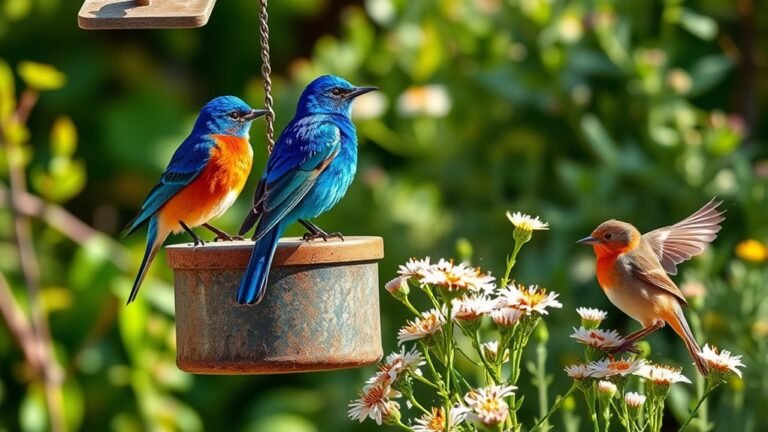The Fascinating Red-Headed Bird Species
Red-headed birds have striking looks and interesting behaviors. Each species, like the bright Scarlet Tanager and the bold Red-headed Woodpecker, has special features that attract birdwatchers and conservationists. Their homes, nesting habits, and feeding methods show their importance in nature. Understanding these aspects helps us see their ecological roles and the issues they face. What affects their survival and ability to adapt in a changing world?
Key Takeaways
- The Red-headed Woodpecker has a bright red head, black wings, and white belly, making it visually distinct among bird species.
- Known for its impressive drumming skills, this woodpecker communicates and claims territory effectively using rhythmic sounds.
- Red-headed Woodpeckers nest in dead trees, often returning to the same cavities each breeding season for reproduction.
- Their agile diving ability allows them to catch insects mid-air, showcasing their hunting prowess and adaptability.
- Conservation efforts are crucial for their habitat preservation due to threats from urban development and agricultural expansion.
The Scarlet Tanager: A Vibrant Summer Visitor

The Scarlet Tanager is a bright bird found in deciduous forests during summer. Its vibrant red feathers stand out.
This bird lives in the eastern United States and migrates to Central America for winter. When it returns in spring, it moves through the tree canopy, searching for food.
Scarlet Tanagers mainly eat insects like beetles and caterpillars. They also enjoy ripe fruits, especially berries.
This diet helps keep them healthy and aids in seed dispersal in forests. Spotting a Scarlet Tanager enhances outdoor experiences. It connects you to nature and its lively creatures.
The Red-headed Woodpecker: Master of Drum and Dive
The Red-headed Woodpecker stands out with its bright red head, white belly, and black wings. This bird is known for its impressive drumming skills, which it uses to communicate and claim territory.
Here are three key features:
- Drumming Skills: Red-headed Woodpeckers create different drumming patterns to signal their presence and attract mates.
- Nesting Preferences: They prefer to nest in holes of dead trees and often return to the same locations each year.
- Diving Ability: Their skillful dives allow them to catch insects effectively.
These traits emphasize the Red-headed Woodpecker's important role in nature and attract many bird watchers.
The Northern Cardinal: A Symbol of Beauty and Resilience

The Northern Cardinal is a colorful bird known for its bright red feathers. It holds significant meaning in many cultures.
People often see it as a symbol of love, hope, and joy. Many believe it acts as a messenger from the spirit world, representing strength during tough times.
Spotting a Northern Cardinal can bring comfort and remind you to appreciate life's moments. Take a moment to enjoy this beautiful bird and understand its cultural importance.
This connection can deepen your appreciation for nature and enhance your sense of belonging.
The Crimson-collared Grosbeak: A Jewel of the Tropics
Have you seen the vibrant colors of the Crimson-collared Grosbeak? This beautiful bird lives in Central America and stands out in its tropical home.
Here are some key points about it:
- The bird has a striking crimson collar that contrasts with its black feathers.
- It plays an important role in spreading seeds, which helps the ecosystem.
- Protecting its tropical habitat is crucial for its survival.
Watching the Grosbeak feed reveals the balance of nature.
The Ruby-crowned Kinglet: Small Size, Big Personality

The Ruby-crowned Kinglet is a small bird known for its vibrant crown and lively behavior. Birdwatchers enjoy observing its energetic actions as it moves quickly between branches.
This bird feeds by catching insects in mid-air or looking for food among leaves. It can thrive in different places, such as forests and city parks.
You might notice its fearless nature, as it often approaches people during outdoor activities. Watching these small birds helps you connect with nature and appreciate the joy they bring to birdwatchers.
The House Finch: Colorful Urban Adaptation
The House Finch is a common bird in urban areas. They adapt well to city life. Here are some interesting facts about them:
- Nesting Habits: House Finches build nests in various places, such as under eaves and on signs. This shows how well they fit into urban environments.
- Eating Habits: They've a varied diet that includes seeds, fruits, and scraps from human food, making them easy to spot in neighborhoods.
- Social Behavior: House Finches often sing in groups. This social interaction creates a lively atmosphere that connects them with city residents.
Their colorful presence can remind us of nature's resilience.
The Red-bellied Woodpecker: Distinctive Markings and Calls
The Red-bellied Woodpecker is easy to identify in North American woodlands due to its striking colors.
It has a light belly, a red nape, and bold black-and-white markings on its back. These features help attract mates and provide camouflage among trees.
The woodpecker forages for insects and fruit, tapping rhythmically on tree trunks.
Its calls echo through the forest, with clear, rolling coos that can easily be heard.
Understanding these characteristics helps you appreciate the Red-bellied Woodpecker's role in the ecosystem and connect with nature's beauty.
The Vermilion Flycatcher: A Flash of Red in Open Spaces
The Vermilion Flycatcher is a vibrant bird found in open areas, particularly in dry landscapes. It stands out with its bright red plumage, often seen resting on low branches.
Here are some important facts about the Vermilion Flycatcher:
- Habitat: This bird prefers open woodlands, savannas, and wetlands. It actively hunts for insects in these areas.
- Behavior: The Vermilion Flycatcher flies swiftly, using quick sprints and sharp turns to catch its food.
- Social Behavior: You often see them alone or in pairs. They communicate through territorial displays and vocal sounds.
Seeing a Vermilion Flycatcher adds a striking touch of color to nature. Its presence invites a greater appreciation of the beauty around us.
The Painted Bunting: Nature's Living Rainbow
The Painted Bunting is a vibrant bird known for its eye-catching colors. Male Painted Buntings have bright blue, green, yellow, and red feathers, resembling a colorful rainbow.
These birds migrate from North America to Central America for the winter. Watching their migration can help you appreciate their strength and dedication.
The Painted Bunting's beauty and life cycle connect us to nature and highlight the important balance in our ecosystems. Observing them gives a sense of belonging to the natural world.
Habitat Conservation: Protecting Red-Headed Birds and Their Environments
As urban development and agriculture lead to habitat loss, protecting red-headed bird species becomes critical.
Here are ways to support conservation efforts:
- Advocate for habitat restoration. Focus on projects that restore native plants, which red-headed birds need for nesting and feeding.
- Join local conservation groups. Engage in activities that help preserve natural habitats.
- Educate your community. Share information about the importance of red-headed birds and their role in the ecosystem.
Red-headed birds are essential for our environment.
By getting involved in conservation efforts, you help preserve these beautiful birds and their habitats for future generations.
Your participation enhances the connection between nature and your community.
Frequently Asked Questions
What Are the Different Species of Red-Headed Birds?
Red-headed birds include species like the red-headed woodpecker and the scarlet tanager. The red-headed woodpecker has a bright red head, white body, and black wings. It often relies on trees for foraging insects. The scarlet tanager features vibrant red plumage in males during the breeding season, while females are yellow-green. This bird prefers mixed forests and can often be seen foraging in trees. Both birds highlight the variety of colors and behaviors found in the avian world, making them fascinating subjects for birdwatchers and nature lovers.
How Can I Attract Red-Headed Birds to My Backyard?
To attract red-headed birds to your backyard, place bird feeders filled with seeds and insects that these birds like. Choose native plants that provide shelter and food, creating a welcoming space for these colorful birds. Keeping your yard clean and providing water sources can also help bring them closer. Enjoy watching these beautiful birds visit your outdoor area!
What Do Red-Headed Birds Eat?
Red-headed birds have varied diets. They often eat seeds, fruits, and insects. By offering these foods in your backyard, you can attract these birds and increase the diversity of wildlife in your area. Watching these vibrant birds can bring joy and beauty to your outdoor space.
Where Can I Find Red-Headed Birds in the Wild?
To find red-headed birds in the wild, look for them during their migration seasons. Visit local parks or wetlands at dawn. This is when they search for food and are most active. Enjoy the birdwatching experience!
Are Red-Headed Birds Endangered or Threatened?
Many red-headed birds are declining in number due to habitat loss and changes in the environment. Conservation efforts work to protect these birds. These efforts aim to increase their populations and ensure they thrive in nature for future generations. Protecting these birds is vital for maintaining biodiversity and the balance of our ecosystems.

Hello, I’m Amelia White, the founder of birdsfanatic.com. As a lifelong bird enthusiast and spiritual seeker, I’ve always been fascinated by the mystical connections between birds and the human experience. On this site, I share my knowledge and insights into the symbolic meanings and spiritual significance of various bird species, exploring their roles in mythology, folklore, and cultural traditions. Join me on this journey into the world of birds, where we’ll discover the hidden wisdom and guidance that these magnificent creatures have to offer.







